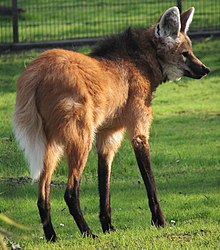Maned wolf
The maned wolf (Chrysocyon brachyurus) is the largest canid of South America. Its markings are like those of foxes, but it is not a fox or a wolf. It is the only type in the genus Chrysocyon, which means "golden dog".
| Maned wolf[1] Temporal range: Late Pleistocene – Recent
| |
|---|---|

| |
| Maned wolf in Cologne Zoo, Germany | |
| Scientific classification | |
| Domain: | Eukaryota |
| Kingdom: | Animalia |
| Phylum: | Chordata |
| Class: | Mammalia |
| Order: | Carnivora |
| Family: | Canidae |
| Subfamily: | Caninae |
| Tribe: | Canini |
| Genus: | Chrysocyon Smith, 1839 |
| Species: | C. brachyurus
|
| Binomial name | |
| Chrysocyon brachyurus (Illiger, 1815)
| |

| |
| Range of the maned wolf | |
| Synonyms[3] | |
|
Canis brachyurus, C. campestris, C. isodactylus, C. jubatus, Vulpes cancrosa | |
The maned wolf has long, thin legs and thick reddish fur. The maned wolf is an omnivore. It has an important job in the seed dispersal of fruits, especially the wolf apple. The maned wolf usually lives alone. It communicates with other maned wolves by giving a loud call known as "roar-barking".
The maned wolf lives in open and semi open habitats, especially in grasslands. It lives in south, central-west, and southeastern Brazil, Paraguay, northern Argentina, and Bolivia, southeastern Peru. It is very rare in Uruguay. It is a near threatened species.[4][5]
References
change- ↑ Wozencraft, W. C. (2005). "Order Carnivora". In Wilson, D. E.; Reeder, D. M (eds.). Mammal Species of the World (3rd ed.). Johns Hopkins University Press. pp. 532–628. ISBN 978-0-8018-8221-0. OCLC 62265494.
- ↑ Rodden, M.; Rodrigues, F. & Bestelmeyer, S. (2008). "Chrysocyon brachyurus". IUCN Red List of Threatened Species. 2008. Retrieved 22 March 2009. Database entry includes justification for why this species is near threatened.
- ↑ Osgood, Wilfred H. (1919). "Names of Some South American Mammals". Journal of Mammalogy. 1 (1): 33–36. doi:10.2307/1373718. JSTOR 1373718.
- ↑ Rodden, M.; Rodrigues, F. & Bestelmeyer, S. (2008). "Chrysocyon brachyurus".
{{cite web}}: CS1 maint: multiple names: authors list (link) - ↑ Wozencraft, C. W. (2005). Mammal Species of the World: A Taxonomic and Geographic Reference. ISBN 978-0-8018-8221-0.
